A Guide to Electrical Rewiring Cost in Singapore: What Homeowners Need to Know
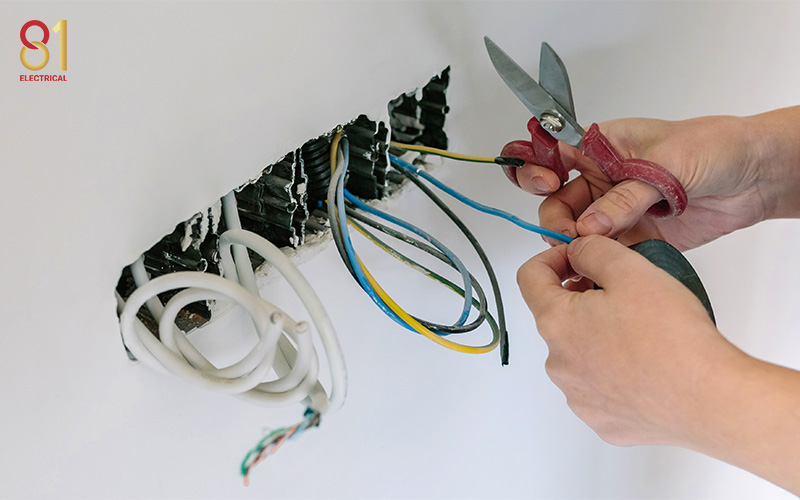
Introduction
If you live in an older HDB flat or private property in Singapore, your home’s wiring may be long overdue for an upgrade. Many electrical systems installed decades ago were not designed to support the heavy load of today’s modern appliances or meet today’s strict safety requirements. Without proper checking, ageing or damaged wiring can pose serious risks, including short circuits, fires, and electric shocks.
Rewiring may not be the most glamorous home improvement project, but it’s one of the most important for ensuring your family’s safety and your home’s functionality. Whether you’re renovating, expanding your power needs, or simply being proactive, understanding the electrical rewiring cost in Singapore can help you plan your electrical work more effectively.
In this article, we break down what goes into house rewiring costs, what influences the price, and what to expect during the process.
Key Takeaways:
What Factors Drive Up Electrical Rewiring Costs in Singapore?
The main cost influencers include your flat size, the extent of rewiring required, material quality, and labour rates. Larger homes and concealed wiring systems typically increase both labour and material costs. Opting for premium components and engaging experienced contractors may raise upfront costs, but they offer better long-term safety and durability.
What Should a Proper Electrical Rewiring Quote Include?
A comprehensive quote should clearly list wiring supply and installation, lighting and power point counts, trunking or concealed wiring options, labour, safety testing, permit applications, and patch-up work. Always ensure material costs are included and not quoted separately to avoid underestimating your total spend on electrical Rewiring Costs in Singapore.
What are the Expected Electrical Rewiring Costs in Singapore in 2025?
Average electrical rewiring costs in Singapore range from $2,000 to $10,000+, depending on the flat size and scope. For example, rewiring a 4-room flat typically falls between $4,000 and $8,000, with sample package pricing starting from around $3,399. Always add a 10–15% buffer for variation orders or material upgrades.
How Can I Keep My Electrical Rewiring Costs in Singapore Under Control?
Save by combining rewiring with renovation works, prioritising essential electrical points first, and opting for surface trunking in non-essential areas. Always request detailed, itemised quotes and compare 2–3 EMA-licensed contractors to ensure transparency and competitive pricing.
Why Is It Important to Choose a Licensed Electrical Contractor?
Only EMA-licensed electricians are legally allowed to perform home renovation electrical works in Singapore. They ensure compliance with SP Group, HDB, and SCDF regulations, reducing the risk of faults, delays, or resale complications. Reputable providers will also manage permit applications and carry out proper testing and commissioning.
Understanding Electrical Rewiring Needs and Quotes
Why Rewire Older HDB Flats?
Rewiring an older HDB flat is a key step to ensure long-term safety and efficiency. Many flats built before the 1990s still operate on outdated wiring systems that were never intended to support the demands of today’s modern households. Homeowners should consider rewiring due to:
1. Safety Concerns
Electrical wiring naturally deteriorates over time due to wear and tear, heat exposure, and pest damage. Frayed insulation, loose connections, or corroded wires can become ignition points for fires or lead to electric shocks. Replacing aged wiring greatly reduces these risks, offering greater protection for your family and property.
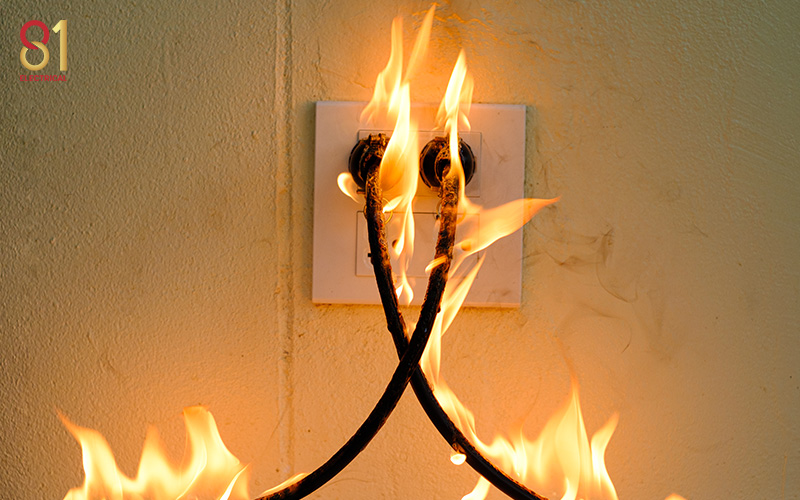
2. Higher Electrical Demand
The average Singaporean household today is packed with high-powered devices. These include induction cookers, washing machines, air conditioners, and charging stations for multiple smart devices. Old electrical systems often lack the capacity to safely manage this increased load, resulting in frequent power trips or overheating. Rewiring allows you to install properly rated circuits that support current and future usage needs.
3. Updated Codes and Compliance
Singapore’s electrical regulations have evolved to meet higher safety and energy standards. Outdated installations may fall short of these requirements. By rewiring your home, you ensure full compliance with SP Group and Energy Market Authority (EMA) regulations, which is especially important during renovation works or property resale.
4. Improved System Reliability
New wiring systems use higher-quality insulation and materials that offer improved resistance to heat, moisture, and corrosion. This results in fewer electrical faults, reduced maintenance, and electrical wiring with a longer lifespan. Ultimately, it contributes to a smoother, disruption-free living environment.
5. Energy Efficiency and Smart Home Compatibility
Rewiring also paves the way for energy-efficient living. It enables better circuit segmentation, optimised load distribution, and the integration of energy-saving appliances and smart home systems. This not only reduces your carbon footprint but can also lower monthly electricity bills in the long run.
When evaluating electrical rewiring costs in Singapore, it’s essential to factor in the condition and age of your current setup, the type of property, and your household’s energy needs. A tailored quote from a licensed electrical contractor in Singapore will give you a clearer picture of the investment needed to future-proof your home.
What Are the Factors That Influence Electrical Rewiring Costs in Singapore?
The electrical rewiring cost in Singapore can vary depending on several key factors. Understanding these elements will help you budget accurately and avoid unexpected expenses during your renovation or upgrade project.
Here’s a closer look at what drives the final price:
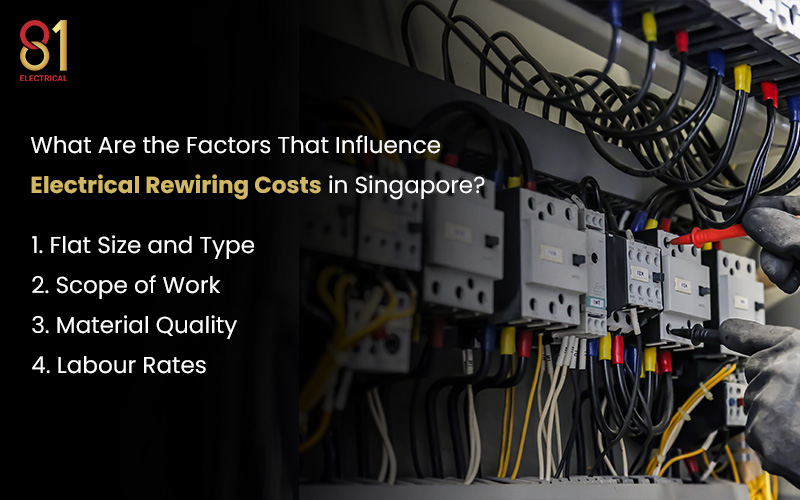
1. Flat Size and Type
One of the biggest cost drivers is the size and layout of your property. Rewiring a standard 3-room HDB flat will generally cost less than rewiring a larger 5-room flat, maisonette, or landed property. Larger homes require more cabling, more sockets, and often more distribution points. This results in longer labour hours and increased material usage.
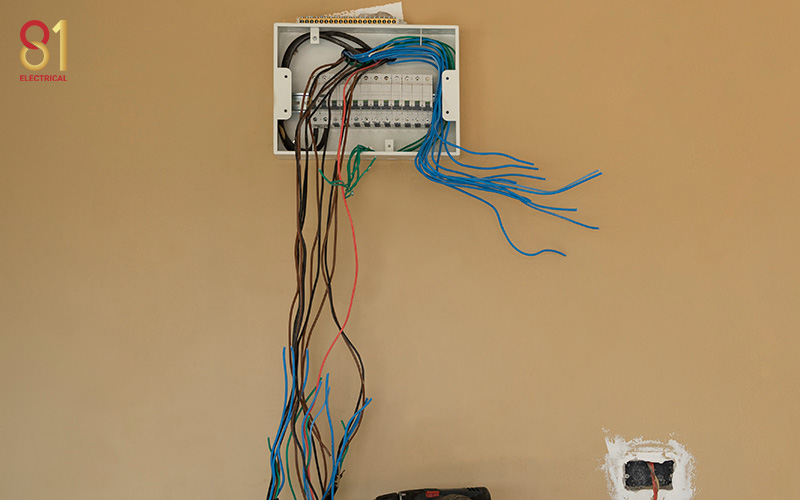
2. Scope of Work
The extent of your rewiring project matters. A full rewiring job, which includes replacing all existing wires, installing new trunking, and upgrading the distribution board (DB box), will cost more than partial rewiring. Adding extra power points, data points, or dedicated circuits for heavy appliances like air conditioners or water heaters will also push up the total.
3. Material Quality
Not all electrical components are created equal. While it might be tempting to opt for budget-friendly parts, investing in premium-quality sockets, switches, and fire-rated cables offers greater durability and enhanced safety. Higher-quality materials may increase upfront costs, but they reduce the risk of future faults and are often more aesthetically pleasing.
4. Labour Rates
In Singapore, licensed electrical workers (LEWs) are required to carry out rewiring works to comply with safety regulations. Labour rates can vary based on the contractor’s experience, certifications, and project timeline. While it may be tempting to go with the cheapest quote, it’s essential to ensure that your contractor is EMA-licensed and familiar with HDB or BCA guidelines. Quality workmanship not only ensures safety but also prevents rework that could cost more in the long run.
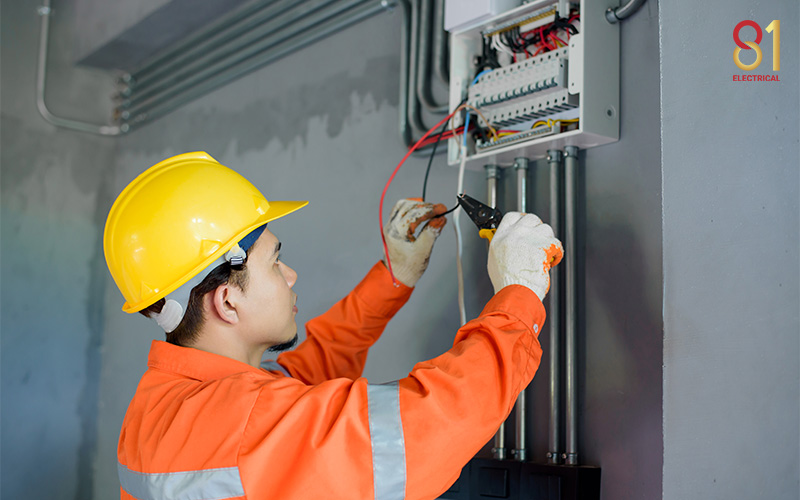
Understanding Electrical Rewiring Costs in Singapore: What Should Be Included?
When planning a home upgrade, understanding the electrical rewiring cost in Singapore involves more than just looking at the bottom line. A detailed and transparent quote ensures that you’re getting the right scope of work to meet safety standards and future-proof your home’s electrical system.
Here’s what a comprehensive electrical rewiring quotes in Singapore should include:
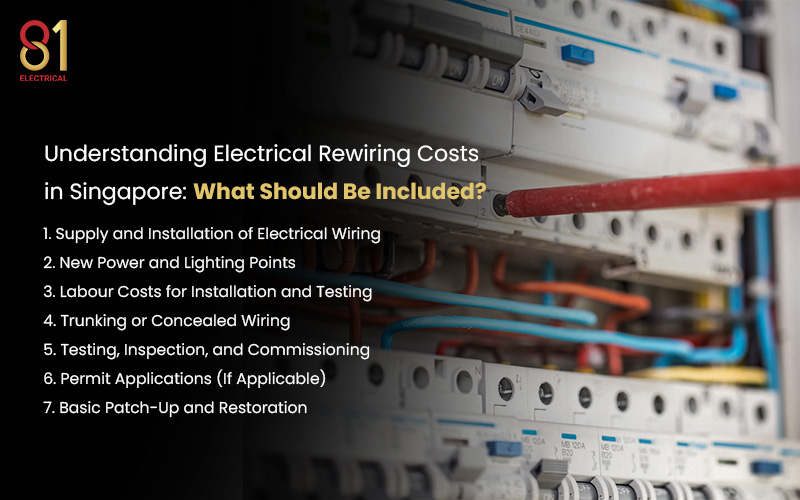
1. Supply and Installation of Electrical Wiring
This is the foundation of any rewiring project. It covers the removal of outdated wires and the installation of new electrical cabling from the distribution board (DB) to every switch, socket, and light point. Charges will vary depending on whether the wiring is run through PVC trunking or concealed within walls and ceilings.
2. New Power and Lighting Points
Most rewiring jobs include installing or repositioning multiple power sockets, switches, and lighting points to suit modern usage. Your quote should clearly list how many points are included and if there’s a cost per additional point. This is one of the main elements that can influence the electrical rewiring costs in Singapore.
3. Labour Costs for Installation and Testing
Labour is a key component of the total cost. It includes the time and expertise required to dismantle old circuits, lay new wiring, connect fixtures, and test the entire system. Professional workmanship ensures that the installation is safe, compliant, and durable.
4. Trunking or Concealed Wiring
Depending on your home’s design and your preferences, the rewiring can be done using surface-mounted trunking or concealed conduits. One difference between concealed vs exposed wiring is the level of labour work. Concealed wiring is often more labour-intensive, thereby driving up the cost. The price may hike, especially when hacking and patching work is involved.
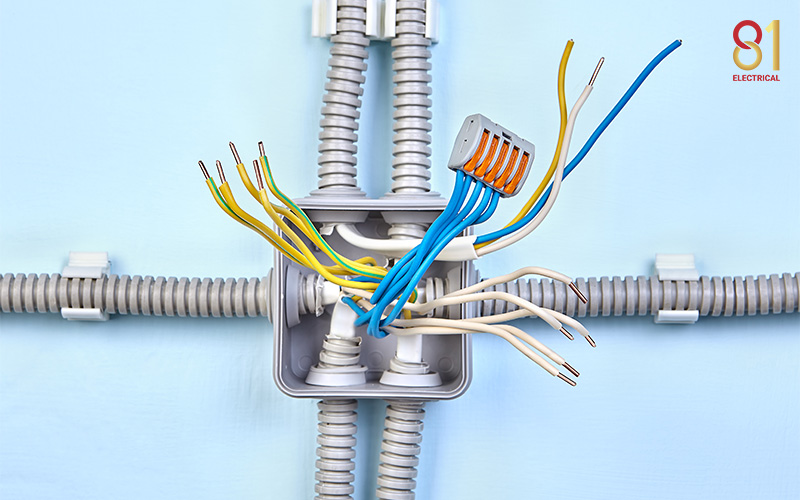
5. Testing, Inspection, and Commissioning
A reliable contractor will carry out all necessary tests, including insulation resistance, earthing, and circuit load checks, to ensure the HDB electrical upgrading or new setup complies with SP Group and EMA regulations. These safety checks are a vital part of what you’re paying for when reviewing electrical rewiring costs in Singapore.
6. Permit Applications (If Applicable)
Some rewiring works, particularly in HDB flats, require formal submissions to HDB or the Singapore Civil Defence Force (SCDF) to ensure compliance with fire safety and housing regulations.
For example, upgrading the distribution board or adding new circuits may need prior approval. A responsible contractor, ideally an EMA-licensed electrician, will be familiar with these requirements and manage the necessary applications on your behalf. These administrative tasks, along with any related fees, are factored into the overall electrical rewiring cost in Singapore. This helps you avoid delays and ensures full compliance with HDB regulations.
7. Basic Patch-Up and Restoration
If concealed wiring is used, minor wall patching (cement or plaster) is usually included. However, painting or full wall restoration may be charged separately. Be sure to ask if this is part of the electrical rewiring cost in Singapore or an additional service.
Last but not least, always clarify whether the price includes materials such as wires, faceplates, switches, circuit breakers, and casings. Some contractors quote these separately, which can misrepresent the actual cost.
What Common Red Flags Should You Watch Out for in a Quote?
Before committing to a contractor, remember to review your quotation carefully. A detailed and transparent quote protects you from hidden costs, substandard materials, or compliance issues. If you’re comparing electrical rewiring costs in Singapore, spotting red flags early can save you from costly mistakes.
1. Unrealistically Low Per-Point Pricing
If a quote seems too good to be true, it probably is. Some contractors may advertise extremely low per-point costs to attract customers. But be mindful of those who intend to cut corners by using substandard wiring, low-grade components, or inexperienced labour. These compromises can lead to electrical faults, fire hazards, and costly repairs later on. Always compare pricing against industry averages and ask for a breakdown of what’s included.
2. No Mention of Permits or Safety Testing
All major rewiring works—especially in HDB flats—require proper safety testing and sometimes prior approval from HDB or SCDF. If your quote doesn’t mention permit applications or post-installation testing, that’s a major red flag.
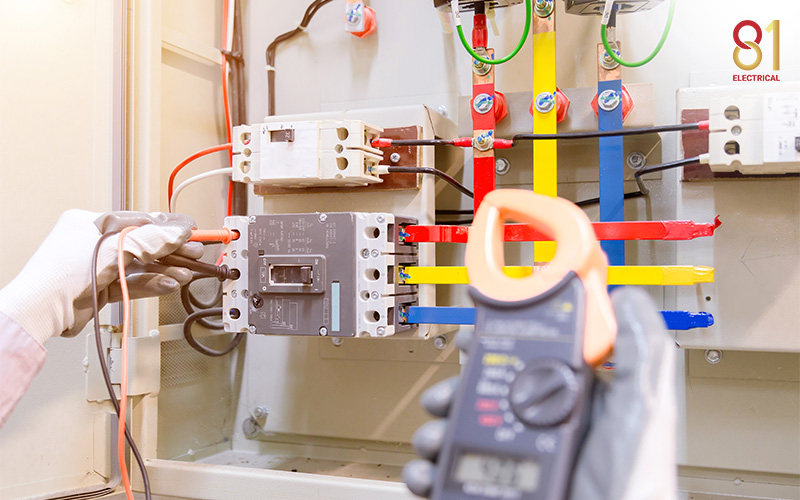
Only licensed electricians are authorised to carry out such electrical works legally in Singapore. In addition, compliance is non-negotiable if you plan to sell or renovate your home in the future. These costs should be clearly included in your total electrical rewiring cost in Singapore.
3. Exclusion of Trunking or Concealed Work Details
Quotes that don’t specify whether the rewiring involves surface-mounted trunking or concealed conduits can lead to confusion and disputes later. Concealed wiring generally costs more due to the additional hacking and patching work, but it’s often the preferred choice for aesthetic reasons. Ensure the quote specifies the wiring method and covers any related labour and material costs.
4. Vague or Incomplete Breakdown
A reputable electrician in Singapore will provide a clear, itemised quote that distinguishes between labour, materials, installation points, optional add-ons, and administrative fees. If your quotation is vague or lacks clarity, don’t hesitate to ask for more details. This not only helps you understand the value you’re getting but also allows for accurate comparisons between different providers.
A Breakdown of Electrical Rewiring Costs in Singapore
How Much Does Electrical Rewiring Cost in Singapore’s HDB Units?
When budgeting for rewiring, it’s helpful to understand the usual cost range for different HDB flat types. In Singapore, electrical rewiring costs are influenced by factors like flat size, the number of power points, and the materials used.
Here are the estimated 2025 price ranges and sample rewiring packages commonly offered by licensed contractors:
1. General Cost Estimates by Flat Type
- 2-Room Flat: SGD 2,000 – SGD 4,000
- 3-Room Flat: SGD 3,000 – SGD 6,000
- 4-Room Flat: SGD 4,000 – SGD 8,000
- 5-Room Flat: SGD 5,000 – SGD 10,000
- Executive Flat: SGD 6,000 – SGD 12,000+
Note: These estimates include labour, materials, rewiring work, new outlets, and distribution board replacements or upgrades. Prices may vary depending on specific home requirements and contractor rates.
2. Sample Rewiring Packages
- 3-Room Flat – From SGD 2,699
- 8 x 2X13A power point sockets
- 2 x 1X13A power point sockets
- 8 x new lighting points (excludes light fixture installation)
- 1 x 20A water heater point
- 1 x 15A aircon point
- 1 x 10-way distribution board with components
- 4-Room Flat – From SGD 3,399
- 10 x 2X13A power point sockets
- 2 x 1X13A power point sockets
- 12 x new lighting points
- 2 x 20A water heater points
- 1 x 15A aircon point
- 1 x 12-way distribution board with components
- 5-Room Flat – From SGD 5,299
- 12 x 2X13A power point sockets
- 2 x 1X13A power point sockets
- 14 x new lighting points
- 2 x 20A water heater points
- 1 x 15A aircon point
- 1 x 14-way distribution board with components
How to Budget for Electrical Rewiring
When planning for rewiring, having a realistic budget helps you avoid cost overruns and unnecessary stress. In this section, we take a closer look at how to approach electrical rewiring costs more strategically:
1. Estimate Costs by Flat Size
Understanding average price ranges based on your HDB flat size gives you a solid starting point:
- 2-Room Flat: $2,000–$4,000
- 3-Room Flat: $3,000–$6,000
- 4-Room Flat: $4,000–$8,000
- 5-Room Flat: $5,000–$9,000+
These estimates typically include power and lighting points, DB box upgrades, wiring materials, and labour. Complex layouts or concealed wiring will push costs toward the higher end.
2. Include a 10–15% Buffer
Always add a contingency buffer of 10–15% for variation orders. Common add-ons include extra power points, upgraded switches, or better-quality materials. This helps you stay within budget even if changes arise during installation.
3. Full vs Partial Rewiring
Full rewiring ensures your entire home’s system is safe, compliant, and ready for future tech upgrades. Partial rewiring costs less upfront but may leave some outdated wiring in place. So, be mindful that this can affect long-term reliability and resale value.
4. Payment Terms
Choose phased payments tied to milestones rather than a lump sum upfront. This protects you against incomplete work and gives you better control over your spending. Take a 4-room flat as an example. Give a 10% buffer that totals about $6,000 for the average full rewiring priced around $5,500.
Tips for Homeowners: How to Save on Electrical Cost
Lowering your electrical rewiring cost in Singapore doesn’t mean compromising on safety. These practical tips can help you manage expenses while still getting quality results:
1. Combine Rewiring with Renovation Works
If you’re already planning to hack tiles or redo ceilings, it’s more cost-effective to schedule rewiring during the renovation. This reduces labour duplication and makes it easier to conceal wiring, especially for lighting and air conditioning points.
2. Request Itemised Quotes and Avoid Vague Pricing
Ask for a full breakdown of costs by labour, power points, and materials. Avoid contractors who only provide a lump sum without clarity. It’s a red flag for hidden costs or poor-quality work.
3. Prioritise Essential Points First
If you’re working with a limited budget, focus on critical electrical needs: lighting, power sockets, air-conditioner points, and water heater circuits. Decorative features like cove lights or under-cabinet LEDs can be added later.
4. Use Surface Trunking Where Concealed Wiring Isn’t Needed
For areas like kitchens, service yards, or rental units, surface trunking offers a practical and affordable alternative. It’s easier to install, maintain, and upgrade later if needed.
5. Compare at Least 2 to 3 EMA-Licensed Contractors
Make sure your shortlisted contractors are EMA-licensed and have solid experience with HDB rewiring. Ask to see past project photos or client testimonials to gauge their workmanship.
Frequently Asked Questions
1. Will rewiring increase the resale value of my home?
Yes. A recently rewired home is a major selling point during resale. Buyers value:
- Peace of mind from reduced fire risk
- Modern DB boxes and enough power points
- Support for high-powered appliances and smart home devices
2. Why is concealed wiring more expensive than exposed wiring?
Concealed wiring requires hacking into walls or ceilings, followed by plastering or repainting. This increases both labour time and material costs. Exposed wiring, on the other hand, is faster to install using surface-mounted trunking, which is cheaper but may affect aesthetics.
3. Can I save money by doing partial rewiring?
Yes. If only certain areas (e.g., kitchen, bedrooms) need upgrades, partial rewiring can significantly reduce costs. However, this depends on the condition and layout of your existing wiring system.
Conclusion
Electrical rewiring is a smart investment in safety, energy efficiency, and long-term peace of mind. As part of your home renovation electrical works, always prioritise licensed professionals who understand the specific requirements of HDB flats and private properties in Singapore. Working with a trusted provider not only ensures compliance with local regulations but also prevents costly issues down the line.
With a team of licensed and experienced electricians, 81 Electrical provides reliable and compliant electrical services in Singapore. From rewiring and DB box upgrades to routine inspections and troubleshooting, we ensure your wiring is always safe and efficient.
Don’t leave safety to chance. Contact us to put quality and compliance first. Choose 81 Electrical.



